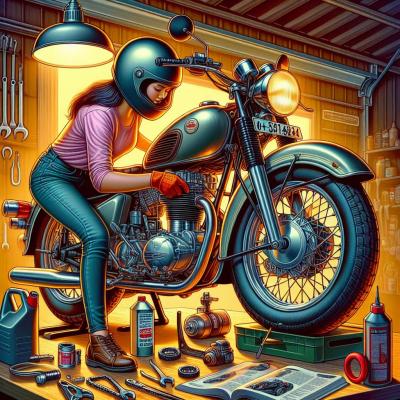Maintaining a motorcycle in top condition is directly linked to its reliability and lifespan. Through routine care, vital components of your bike, such as the engine and transmission, can run smoothly for years to come. In fact, statistics have shown that motorcycles that receive regular maintenance can enjoy an extended lifespan, potentially outliving those that have been neglected by a significant margin.
Consider this: a rider once noticed a small inconsistency in the performance of their bike. Rather than dismissing it as a fluke, they decided to investigate and perform some basic maintenance. This quick intervention revealed a minor issue that was on the cusp of turning into a major, costly problem. With routine checks and timely action, the owner not only avoided a breakdown but also preserved the longevity and value of their motorcycle. This anecdote serves to remind us that dedication to maintenance can and does forestall many of the issues that might otherwise lead to the untimely end of a motorcycle's journey.
Understanding Your Motorcycle's Needs
Just like any valued possession, your motorcycle comes with its own set of needs that are pivotal to its optimal operation. Every bike has distinct components that demand regular checks—be it the heart and soul of the machine, the engine, the critical braking system, or the tyres that keep you grounded. Acknowledging and learning about these unique requirements is the key to ensuring your motorcycle performs at its peak.
The motorcycle manual isn't just another booklet to be tossed aside; rather, it's the bible of your motorcycle's maintenance. This guide contains a goldmine of information, from service intervals to the nuances of care needed for different machine parts. Each page is designed to help you understand the specific maintenance schedule tailored to your bike's design and features.
Your riding style and environment also play significant roles in determining how frequently your motorcycle needs maintenance. An adrenaline-fueled ride on a dirt track will pose a different strain on your motorcycle compared to a smooth cruise down city streets. Likewise, motorcycles in coastal areas may require more frequent care to combat rust and corrosion caused by salty air. Understanding these factors will help you anticipate their effects on your bike and adjust your maintenance schedule accordingly to suit your riding habits and environmental conditions.
The Fundamentals of Motorcycle Maintenance
Maintaining a motorcycle is not unlike caring for a trusted friend; it requires regular check-ups and attention to detail to ensure its well-being. At the core of motorcycle maintenance are a few essential tasks that keep the machine running effectively and safely.
Regular Oil and Filter Changes
The lifeblood of any motorcycle's engine is its oil, which keeps the internal components lubricated and running smoothly. Over time, engine oil can degrade and become contaminated with particles, which makes regular changes crucial. Likewise, oil filters play a vital role in trapping debris that can wear down an engine over time. Adhering to the oil and filter change schedule as recommended in your motorcycle's manual is essential to prevent premature engine wear.
The Importance of Checking and Adjusting Tire Pressure
Tyres are the only point of contact between your motorcycle and the road, and their condition is paramount to your safety. Properly inflated tyres ensure optimal performance, handling, and fuel efficiency. They also help to prevent uneven wear and potential blowouts. It's advisable to check your tyre pressure regularly, adjusting it as needed to match the manufacturer's specifications.
Cleaning and Lubricating the Chain
A motorcycle's chain is responsible for transferring power from the engine to the rear wheel. To maintain this smooth transmission, the chain must be kept clean and well-lubricated. Dirt and grime can cause increased friction and wear, so a routine of cleaning and lubricating the chain will help to keep it in good working condition, ensuring optimal performance and extending its lifespan.
Inspecting Brake Pads and Discs
Brakes are among the most critical safety features on your motorcycle. Over time, brake pads and discs can become worn, reducing their effectiveness. Inspecting these components for wear and replacing them when necessary is a must to maintain your ability to slow down and stop effectively. Don't overlook the brake fluid, too; it should be replaced at intervals specified by your bike's manufacturer to maintain optimum braking performance.
Ensuring All Lights and Indicators are Functioning Correctly
Visibility is key to safety when riding. This means making sure all lights and indicators on your motorcycle are functioning correctly. Regularly check headlights, brake lights, turn signals, and any additional illumination. Not only is this critical for your safety, but it's also a legal requirement, as faulty lights can lead to fines or worse, accidents.
Seasonal Motorcycle Maintenance Tips
As the seasons change, so do the maintenance needs of your motorcycle. Understanding and anticipating these variations in care will not only extend the life of your motorcycle but also enhance your riding experience. Each season presents its own set of challenges and opportunities for maintaining the health of your ride.
Preparing Your Motorcycle for Winter Storage
Before the chill of winter sets in, it's imperative to prepare your motorcycle for storage to prevent any weather-related damage. This includes changing the oil, adding fuel stabilizer to a full tank to prevent corrosion, and disconnecting the battery. Covering the motorcycle with a breathable cover and storing it in a dry place will also protect it from the elements and keep it ready for the next riding season.
De-Winterizing Your Bike for Spring
As spring blossoms, it's time to de-winterize your bike. Check tire pressure, fluid levels, and ensure the battery is charged. Additionally, it's wise to give your motorcycle a thorough inspection to verify that no pests have made a home in it during the winter season, checking air filters and exhausts for blockages.
Checking Coolant Levels Before Summer Riding
With the summer heat, your motorcycle's engine will be running hotter than usual; thus, it's essential to check the coolant levels. Ensuring the cooling system is functioning correctly can prevent overheating. Airflow is vital, so make sure radiators are clear of debris and the cooling fan operates as it should.
Special Considerations for Fall Riding and Maintenance
Fall brings about a drop in temperature and possibly wetter conditions, which can affect traction and visibility. Inspecting and replacing worn tires and brake components becomes even more critical. Cleaning and protecting metal surfaces with a suitable product can also help safeguard against the increased moisture in the air that autumn can bring.
When to Call the Professionals
While many motorcycle maintenance tasks are manageable by riders themselves, there are certain times when professional expertise is irreplaceable. Knowing when to call the professionals can save you time, money, and potentially even your life. Regular maintenance by a skilled mechanic can ensure that underlying issues do not go unnoticed and that your motorcycle remains in roadworthy condition.
Identifying Issues That Require a Mechanic's Expertise
Complex engine troubles, electrical glitches, and suspension concerns are some problems that typically require a professional's touch. Warning signs like unusual noises, oil leaks, or a change in the bike's handling should prompt a visit to the repair shop. Even seasoned riders might struggle to diagnose and fix such issues, and a mechanic's detailed knowledge and specialized tools are crucial in these instances.
The Benefits of Having a Trusted Motorcycle Repair Shop
Developing a relationship with a trusted mechanic or repair shop ensures consistent care and can often mean that potential problems are identified and addressed before they become severe. A reputable professional will not only perform necessary tasks but can offer individualized advice based on the condition of your motorcycle and your particular usage patterns.
How Often to Schedule Professional Inspections
In general, scheduling a professional inspection at least once a year or as recommended in your owner's manual is good practice. However, this might vary based on the bike's age, mileage, and the rider's personal usage habits. Before and after long trips or if you've stored your motorcycle for an extended period, these are also optimal times to seek a pro's opinion to ensure everything is functioning correctly.
Cost vs. Benefit: The Economics of Motorcycle Maintenance
Striking the right balance between maintenance costs and the benefits it delivers is an essential part of motorcycle ownership. Regular maintenance may seem like a persistent expense, but neglecting it can lead to far more severe financial implications. Analyzing the cost of maintenance versus the cost of major repairs or replacements reveals a clear picture: investing in routine care can prevent the hefty expenses associated with major breakdowns.
The costs associated with motorcycle maintenance are an investment in the bike’s performance, safety, and longevity. Ignoring small, routine tasks can compromise crucial components of your motorcycle, leading to major repairs that often cost several times more than the preventive measures would have. The economics of motorcycle maintenance is a matter of paying a little now to save a lot later. An oil change or tire rotation is far more cost-effective than an engine rebuild or replacing worn-out tires due to neglect.
Maintaining your motorcycle diligently also impacts its resale value significantly. A well-maintained bike can command a higher price on the market, reflecting the care it has received. This care is often perceived by potential buyers as a sign that the motorcycle has been respected and is likely to be more reliable. The benefit to the seller is tangible, as the investment in regular maintenance can yield returns when the time comes to sell or trade in.
Beyond these long-term considerations, routine maintenance also translates to immediate cost savings through better fuel efficiency. A motorcycle in top condition operates more efficiently, squeezing more kilometers out of every liter of fuel. This is particularly true for elements such as clean air filters, optimized engine performance, and correct tire pressure, all of which contribute significantly to reduced fuel consumption. Therefore, the small cost of maintaining these elements regularly can lead to appreciable savings at the pump over time.
Advanced Maintenance Tips for Motorcycle Enthusiasts
Fine-Tuning Engine Performance
For the motorcycle enthusiast, maintenance goes beyond simple checks and oil changes; it's about maximizing engine performance. Fine-tuning your bike's engine can help achieve smoother acceleration, more responsive power delivery, and overall better running conditions. This can involve adjusting the carburetor (for older models), fine-tuning the fuel injection system, or even re-mapping the ECU (Engine Control Unit) in modern motorcycles. Each of these adjustments should be carried out cautiously and preferably under the guidance of a professional, especially when complex electronic systems are involved.
Upgrading Parts for Better Longevity and Performance
Upgrading certain components of your motorcycle not only boosts performance but may also contribute to its longevity. Parts such as the exhaust system, air filter, and even the spark plugs can be replaced with high-performance alternatives designed to enhance the bike's functionality. While the initial investment might be higher for these premium parts, they are often more durable and can improve the overall riding experience. It's critical to ensure that any upgrades are compatible with your motorcycle's model and that they are installed correctly to maximize their benefits.
Diagnostics Tools and Apps That Can Help Keep Track of Your Motorcycle's Health
In the digital age, a host of diagnostic tools and apps have come to the aid of motorcycle enthusiasts. These technologies offer an easy way to monitor your motorcycle's health, providing real-time insights into various metrics and identifying potential issues before they escalate. With the use of OBD-II (On-Board Diagnostics) scanners and relevant smartphone applications, riders can access data such as engine temperature, fuel efficiency, and error codes directly from their motorcycle's ECU. These tools help to keep a pulse on your motorcycle's performance, ensuring that it is always at its peak condition.
Maintenance Checklist and Schedule
To ensure your motorcycle remains in top shape, adopting a structured maintenance routine is indispensable. Rather than reacting to problems as they arise, a planned approach geared towards prevention will keep your bike running smoothly. Creating a personalized maintenance calendar is a proactive strategy that can help schedule and monitor the necessary upkeep tasks.
Creating a Personalized Maintenance Calendar
Your motorcycle's maintenance requirements will vary based on the model, the environment in which you ride, and your riding habits. By consulting your owner's manual and considering these factors, you can develop a calendar that addresses the unique needs of your bike. Whether it's stored digitally or on paper, this calendar should include all routine services and inspections as recommended by the manufacturer, as well as any additional checks you deem necessary based on your personal usage.
Checklist of Daily, Weekly, and Monthly Maintenance Tasks
Daily tasks might include checking tire pressure, oil levels, and ensuring that all lights are operational. Weekly, you might inspect the chain tension and lubrication, brake fluid levels, and coolant levels if applicable. Monthly tasks could include a more thorough check of the entire motorcycle, ensuring all bolts and fastenings are secure, and looking for any signs of wear and tear or potential issues.
- Daily
- Check tire pressure and tread.
- Verify oil level and look for leaks.
- Ensure lights and indicators work correctly.
- Weekly
- Inspect and lubricate the chain.
- Check brake fluid and coolant levels.
- Test brakes for responsiveness.
- Monthly
- Tighten bolts and fasteners.
- Inspect for signs of wear or damage.
- Check battery charge and clean terminals.
How to Document and Keep Records of Maintenance for Future Reference
Documentation plays a critical role in the upkeep of your motorcycle. Keeping a logbook or a digital record of all maintenance activities, part replacements, and service appointments can serve as a valuable reference over the life of your bike. These records not only provide insights into the motorcycle's history but also serve as leverage in maintaining a high resale value. Be sure to date each entry and include receipts or notes for any work done, whether by a professional or as a part of your DIY maintenance routine.
Educational Resources and Helpful Tools
Embarking on the journey of motorcycle maintenance requires knowledge and guidance, and there are numerous resources at your disposal. Investing time in educating yourself can significantly demystify the complexities of motorcycle care and help you tackle maintenance tasks with confidence. From repair manuals to digital tools, the plethora of resources available today can cater to both novice riders and seasoned enthusiasts alike.
Recommended Reading Materials and Manuals
For motorcycle maintenance beginners, starting with the basics is essential. Model-specific service manuals provide invaluable step-by-step guidance for maintenance procedures and troubleshooting. In addition, general motorcycle repair books can offer insights into common motorcycle issues and repairs, teach you about the tools needed for various tasks, and provide a broader understanding of how your motorcycle works.
Online Forums and Communities for Motorcycle Enthusiasts
Joining online forums and communities presents an opportunity to connect with other motorcycle owners. These platforms are treasure troves of shared experiences, tips, and solutions to problems that others have encountered. More experienced riders often partake in such forums, offering advice and support to those who are new to the world of motorcycle maintenance.
Apps and Tools for Planning and Logging Maintenance
Technology is also your ally in maintaining your motorcycle. Several apps are available that facilitate maintenance scheduling, reminders, and even logging service histories. These apps can track servicing intervals, remind you of upcoming maintenance tasks, and help keep a detailed digital logbook of all the work done on your motorcycle. Some apps even offer features for fuel tracking and expense logging, making them multifunctional tools for every motorcycle owner.
Whether you prefer reading a physical manual or searching through an online database, it's important to use these tools as a supplement to, and not a replacement for, the knowledge and expertise of professional mechanics. By combining the wealth of information available with a practical, hands-on approach, you'll be well-equipped to maintain your motorcycle's performance and ensure its lifespan for years to come.
Conclusion: The Ongoing Journey of Motorcycle Maintenance
Throughout this article, we've journeyed through the crucial aspects of motorcycle maintenance, emphasizing its importance not just as a routine but as a cardinal component of the riding experience. Regular maintenance is the lifeblood that keeps your motorcycle running efficiently, safely, and smoothly. It's an investment in the longevity of your vehicle and ultimately in your enjoyment of the ride.
We've discussed everything from understanding your motorcycle's specific needs to developing a personalized maintenance schedule that aligns with your riding style and environmental conditions. We highlighted the particulars of preventive maintenance, the wisdom of relying on professional services at the right time, and the economic sense of maintaining a machine that provides more than mere transportation—it promises adventure.
A well-maintained motorcycle not only stands the test of time but also elevates the joy of riding it. Embrace the rhythm of maintenance as an integral part of your riding experience. Find satisfaction in the hum of a finely tuned engine, the assurance of responsive brakes, and the gleam of well-cared-for chrome. Each task, from the simple to the complex, contributes to a deeper understanding and a more profound connection with your machine.
In closing, let's be mindful that the path to a fulfilling journey on two wheels is paved with regular maintenance. With the knowledge you've equipped yourself with here, take the wheel confidently, knowing that each turn of the wrench, each inspection, and each service appointment not only safeguards your investment but also enhances the pure bliss of motorcycle riding. May you always enjoy the peace of mind that comes with a meticulously maintained motorcycle, and may the road ahead be forever smooth and adventure-filled.
Last updated: Monday 5th February, 2024









